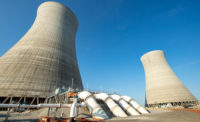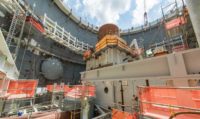After Cutting Workforce, Georgia Power Sticks to Current Vogtle Schedule

Despite shedding roughly 2,000 craft laborers from the Plant Vogtle site in response to the coronavirus pandemic, Georgia Power believes that jobsite productivity will remain high enough for the utility to meet the scheduled in-service dates of November 2021 and November 2022 for the two new nuclear units being built near Waynesboro, Ga.
However, “The next few months will be pivotal as we adjust to a smaller, more streamlined workforce and seek to improve productivity,” said Tom Fanning, CEO of Southern Company, Georgia Power’s parent, during a Q1 earnings call held April 30. He added, “The safety of our workforce and the surrounding community remains paramount, and will continue to guide our decision-making at the site.”
In all, the April workforce reduction decreases the number of project workers to roughly 7,000 from an estimated 9,000.
On May 4, Georgia Power reported that of the 696 Vogtle project workers tested for COVID-19 to date, there have been 185 positive cases. Of the 185 positive cases, 119 individuals had recovered, with the remaining 66 cases still active.
According to the utility, the project is utilizing worker distancing strategies such as adjusted break schedules and the suspension of large group meetings, along with providing an onsite medical clinic.
However, in a May 5 appearance before the Georgia Public Service Commission, Stephen Kuczynski, chairman, president and CEO of Southern Nuclear, noted that social distancing is not always possible.
In those situations, “We provide other mitigating factors such as masks and additional cleaning,” Kuczynski said. “But the most important thing we do is if any of our workforce does not feel well, they go to our medical facility, and we send them home.”
Schedule Confidence
Though November 2021 and November 2022 are the approved in-service dates for Units 3 and 4, respectively, the project team has been working under an “aggressive site work plan” to complete the two new nuclear units earlier than that. Under the current version of this aggressive plan, the project team expects to complete Unit 3 by May 2021 and Unit 4 by March 2022.
Georgia Power estimates that Unit 3’s construction is approximately 90% complete, while the overall project’s construction is about 80% complete.
During the April 30 earnings call, Fanning noted that construction at the Vogtle site during April “was challenged due to COVID-19 impacts, which put us slightly behind the aggressive site work plan.”
Most notably, Fanning continued, mechanical and electrical subcontracting activities related to Unit 3 “began to build a backlog,” due in part to an increase in workforce absenteeism.
Following the 20% cut in the project’s workforce, “We expect to see a decrease in near-term production,” Fanning said, adding that “the longer-term objective is to gain operational efficiency and productivity.”
Despite the COVID-19-induced jobsite impacts to the “aggressive’ schedule, utility officials are confident that Vogtle’s new nuclear units will go online on time.
In a response to questions about the utility’s confidence in the schedule during the May 5 appearance before the Georgia PSC—conducted via video call—executives detailed how the team’s recent productivity rate has put the project in good position to meet the latest target.
“We believe that this schedule is realistic and it's achievable,” said David McKinney, Georgia Power’s vice president of nuclear development. “We’ve got a work plan that is understood.”
Importantly, the utility officials made the case that the productivity rate needed to complete the units in line with the latest schedule is significantly below what the project has achieved during the past year.
For example, added Kuczynski, the project team previously set a goal of completing about 2% of each unit’s construction per month. “Essentially we were able to produce that, on average, all of 2019,” he said.
As a result of that progress, Kuczynski added, the project team had re-evaluated that monthly rate needed to meet the current schedule, and recently lowered that monthly completion figure to just 1%.
“In our view,” he says, that rate “is clearly achievable based on our history that shows that we have done that consistently.”





